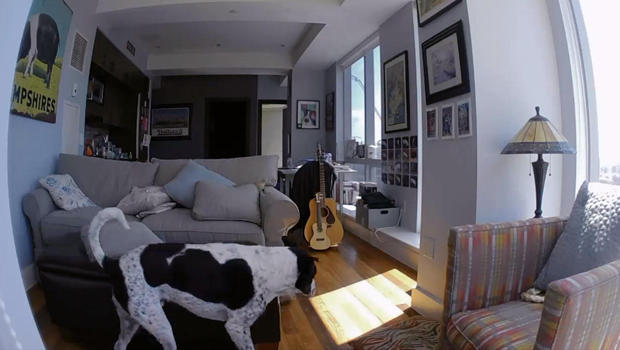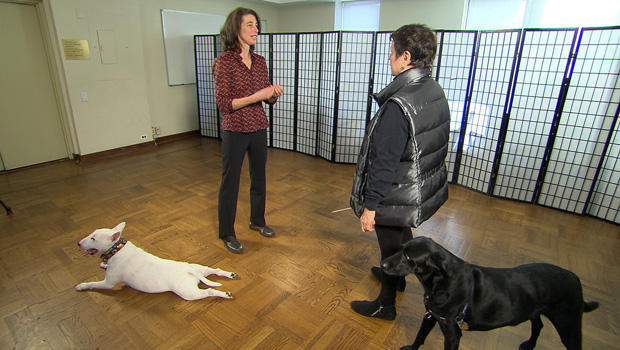A dog’s secret life
What’s day-to-day life like for a dog? What’s going on INSIDE? Our Cover Story comes from our resident dog-lover Martha Teichner:
At BarkBox, a New York City company that sends out treats and toys to dogs every month by subscription, people can bring their dogs to work. The office is literally crawling with them..
And for employees whose dogs are maybe too big or aren’t the office type, “doggie cams” are available as baby monitors.
“What’s great is it has sound, so that I can hear him when he shifts, or he can hear me,” said video producer Zoe Costello, who watches her dog live. “I can, like, holler at him, squeak at him. It feels like a way to sort of have a phone conversation.”
It’s a comfort, she said: “It makes me feel good to see him, to see that he’s okay alone.”
Company controller Matt Hagel is another shameless voyeur, keeping tabs on his dog Monty. “Sometimes, I’ll communicate through it to yell at him if he’s doing something bad,” he said.
“And does he respond?” Teichner asked.
“Yeah, he can hear me.”
“So, if you say ‘no,’ he’ll get it?”
“He’ll get it,” Hagel said, adding, “He may not listen. Normally right when we leave, I think he gets upset, but then after that, he’ll just sleep.”
Hagel leaves music on for Monty when he leaves the house. “He likes reggae.”
But the sleep part -- that’s what most dogs do when they’re home alone. The average dog sleeps 12-14 hours a day.
It’s nothing like the movie “The Secret Life of Pets” (sorry to disappoint). It managed to gross nearly a billion dollars and was one of the summer’s biggest blockbusters.
The point of the movie is that our pets’ lives start the minute we leave. Is that or is that not true?
“I feel like it’s the reverse,” said research scientist Alexandra Horowitz, who studies dog cognition. Her new book is “Being a Dog: Following the Dog Into a World of Smell” (published by Scribner, a subsidiary of CBS).
“They are our social companions. We’ve bred them to be so, and their existence really revolves around our presence and interaction with us, and that’s exactly what they don’t have when we leave them,” she said.
Pets do have a secret life, though. For dogs, it’s mostly about how they experience the world: mainly through their noses.
“The dog’s nose is masterful, it’s such an impressive organ,” said Horowitz.
Humans have about six million olfactory receptors. Dogs? 300 million.
“They sniff more, and they sniff more rapidly than we do,” Horowitz told Teichner. “And that’s because they need to get the odors from the outside world all the way up to the epithelial tissues, the cells that do the smelling, and that’s really at the back of the nose.”
They exhale through those little curled slits on the sides of their noses.
And listen to this: “There is some research which shows that dogs use their right and left nostrils differently,” Horowitz said, “so they start out sniffing with the right and then move to the left, and so there’s a kind of stereo olfaction.”
“Sunday Morning” gathered a few dogs -- Horowitz’s dog, Finnegan; Ricky and June; and Teichner’s dog, Minnie -- to see some noses in action, as when they engaged in a classic greeting ritual.
Teichner asked, “How does a dog know from smelling whether the dog they’re meeting is a friend or an enemy?”
“I don’t think there’s anything inherently friend or foe about a smell,” Horowitz said. “Maybe younger or older, healthy or less healthy, sick or recently eaten something.”
Can they smell fear? Can they smell love? “Yeah, I don’t think it’s too fantastic to say that in some way they can smell fear,” Horowitz said. “In some way they smell love, and that’s because we’re giving off odors that correspond to a state of fear, or a feeling of affection.”
We know about tracking dogs, bomb-sniffing dogs, even bed bug-finding dogs. And now this: “There are now a lot of ex-working dogs who are being trained to detect cancers -- cancers in urine, on breath, in exhaled breath, on the body,” Horowitz said.
But she says dogs can also smell time. “If I leave the house in the morning, my house is full of my smell,” Horowitz said. “An hour later, a lot of it will have disappeared.
“A lot of people talk about dogs who seem to know when their owners are coming home, and they think it might be a kind of psychic ability. But I think it’s a smelling ability, essentially -- not smelling their approach, but smelling how long somebody is gone.”
But one not-so-cute side-effect of smelling time can be separation anxiety, when dogs go crazy and destroy things when their owners leave.
“It’s a very big thing -- it’s like 15-17% of the nation, 73 million dogs, have obvious separation anxiety,” said Dr. Nicholas Dodman, who recently retired as director of the animal behavior program at Tufts University’s Veterinary School. His new book, “Pets on the Couch,” is published by CBS’ Simon and Schuster.
Shadow was returned to a shelter twice before Maya Haraseyko adopted him eight months ago.
“He removed wall-to-wall carpeting, just completely demolished the room,” said Haraseyko. “And was breaking air conditioners, breaking window screens, was trying to get out, barking.”
On a house call to Haraseyko’s Cambridge, Mass., apartment in August, Dr. Dodman outlined his treatment strategy: “We’re gonna kinda get him to expect when the door closes, wonderful things happen,” Dr. Dodman said.
His advice to Haraseyko: Leave as if it’s no big deal, but provide Shadow entertainment -- treats, toys, puzzles. The point is to keep him busy and not bored while she’s out.
And when she comes back, the greeting should be low-key: “You could say, ‘Hey, Shadow, how’s it going? Slap me four!’”
And in Shadow’s case, Dr. Dodman said, “I think also we probably need some kind of medicine, something like, for example, Zoloft.”
Dr. Dodman has spent decades advocating using human mood-stabilizing drugs, like Zoloft, Prozac and others, on pets, because people and animals share the same disorders: “The list would include aggression, phobias, PTSD, obsessive-compulsive disorder, autism, in one model Tourette syndrome, Alzheimer’s, too.”
For separation anxiety, he prescribes behavior modification first, drugs as a last resort.
“Sometimes people are emotionally exhausted, they’re financially drained, and they say, ‘If you can’t fix this problem within two or three months, we’re going to take him to the pound, or we’ll have the vet put him to sleep,’” Dr. Dodman said. “When I hear that, I say, ‘Let’s use the medication.’”
Good news about Shadow: After three months following Dr. Dodman’s prescription, Shadow can be left alone for at least four hours without destroying anything -- a secret life tamer than it used to be, but a lot happier for all concerned.
For more info:
- BarkBox
- “Being a Dog: Following the Dog Into a World of Smell” by Alexandra Horowitz (Scribner); Also available in eBook, Unabridged Digital Audio Download, and Unabridged Audio CD formats
- Dog Cognition Lab at Barnard
- “Pets on the Couch: Neurotic Dogs, Compulsive Cats, Anxious Birds, and the New Science of Animal Psychiatry” by Nicholas Dodman DVM (Simon & Schuster); Also available in eBook format
- “The Secret Life of Pets” (Official site)




